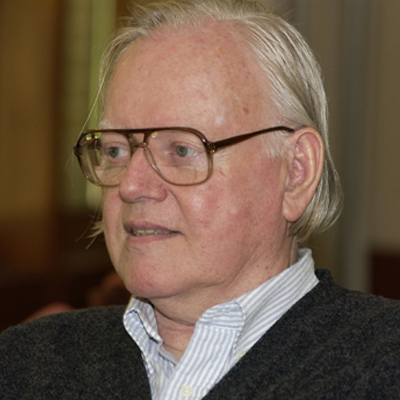Fundamental research uncovers the secrets of bacterial motility
Imagine microscopic things swimming around in your gut, propelled by reversible rotary motors driving propellers of variable pitch, containing rotors, stators, drive shafts, bushings, and universal joints! All quite remarkable and happening at each moment in each of us. It doesn’t take long after contemplating the complexities beneath our exteriors to understand that cells and cell behaviors are complex and in many ways not understood. Despite the centuries of work aimed at investigating such basic science, many questions remain unanswered. Dr. Howard Berg, Herchel Smith Professor of Physics and Professor of Molecular and Cellular Biology at Harvard University, is trying to understand the molecular biology of behavior in the smallest free-living organisms, bacteria; notably in E. coli, a bacterium that lives in your gut. This behavior, known as chemotaxis, enables cells to taste chemicals in their environment and to move toward regions that they deem more favorable. The output device for the sensory system of the cell that monitors the concentrations of chemicals in the external environment is a rotary motor that spins, now clockwise (CW), now counterclockwise (CCW), that enables a cell to opt for new directions of travel, or to swim smoothly toward regions that it deems more favorable. A recent discovery is that the motor can remodel itself to match its operating point, the fraction of time that it spins CW, to the signals generated by the sensory transduction network.
Given the fact that all cells sense and respond to changes in their environment, Dr. Berg’s research is of broad interest. Using easy to study bacteria, he and his team can manipulate cells genetically and determine biochemical mechanisms to shed light on important processes. Therefore, his curiosity-driven research combines his expertise as an experimental physicist and chemist who is medically trained with the interests of his “remarkably creative” postdoctoral fellows and graduate students. With enthusiasm, Dr. Berg describes that E.coli is full of surprises. In fact, he and his team “stumble upon something interesting and unexpected every few years.” Therefore, like an astronomer studying the mysteries of the universe, while we may not know how his research will influence the future of medicine precisely, it is sure to help explain the very essence of our existence on a molecular scale.
Current research includes:
- The Nuts and Bolts: Dr. Berg hopes to understand how bacterial chemotaxis works, every nut and bolt. The biggest black box is the motor. Scientists know a great deal about its electromotive and mechanical properties but do not really know how it works. Dr. Berg is focusing on the functional information required for such knowledge.
- Motor Remodeling: In E. coli, receptors at the input end of the sensory transduction system taste things in the external environment. A network in the middle works to interpret what the receptors taste and to control motors at the output of the sensory transduction system. These motors spin helical filaments that enable cells to move about. Recently Dr. Berg and his team observed that the motor is able to remodel itself depending on the task at hand. They are now working to identify how the motor is capable of such changes and the mechanisms behind this ability.
-
Bacterial Flagella: Some years ago, Dr. Berg made the important discovery that bacterial flagella rotate rather than wave or beat. The helical flagellar filaments that propel swimming cells are quasi-rigid propellers, not bending machines. In short, “nature invented the wheel.” Dr. Berg is trying to understand how these machines are assembled and how they work.
-
Bacterial Motility: Bacteria are capable of incredible movements. Dr. Berg and his team are trying to figure out the strategy that different species use to swim, swarm, twitch, and glide. While these behaviors may be easy to observe, it has been a challenge for scientists to explain how they are generated. Therefore, Dr. Berg hopes to do just that.
Bio
Dr. Howard Berg’s sense of curiosity appears to be innate; he laughs retelling a favorite family story, where at only two years old, he removed the seat of a toilet and brought it to his parent’s guests at a dinner party. While his inquisitive nature grew with him, he began to take an interest in radios and other electronics. His grandfather, a harness maker in Wahoo Nebraska, had a room in his cellar full of radios that Dr. Berg spent time taking apart and putting back together.
Dr. Berg’s interests in the sciences were additionally supported by his father, a professor of biochemistry at the University of Iowa. Recalling with fondness the fun he had with his father’s graduate students, who “didn’t dare give [him] a hard time,” Dr. Berg learned about experiments of many different kinds. It was at his father’s lab that his interest in research first began and eventually migrated, via medicine, to specific interests in physiology and biophysics.
His current research interests concern the motile behavior of bacteria, in part because they are the simplest free-living things. By combining genetics and biochemistry with physiology, one can understand every nut and bolt!
In his free time, Dr. Berg designs and builds scientific instruments. He is an expert in precision instrument making and in electronics. Prior to the digital age, he took black-and-white photographs as a hobby. He also collected vacuum tubes; by the time he donated his collection to MIT, he had every type of US receiving tube made between 1917 and 1935.
Website: http://www.rowland.harvard.edu/labs/bacteria/index.php


